
Birdfeeders
There are several challenges when putting out birdfeeders for wild birds. If they are within reach of squirrels or deer, those animals will empty the birdfeeders.
To handle the squirrels only, special birdfeeders can be used, which are weight-sensitive. Birds are much lighter than squirrels, so a weight-activated birdfeeder will close with the weight of a squirrel.
There's only one brand I'm aware of which consistently works -- Squirrel Buster. They are Canadian-designed, come in various designs and sizes, and are expensive.
The "cage" type is ideal for the most variety of birds — birds can feed from perches or perch on the metal cage enclosure (even upside down), and it comes in two basic sizes. Its drawback is that the larger one holds only about a quart / litre of birdseed. The amount of weight that will make it close cannot be adjusted.
The other type has a ring at the bottom, is much larger, and the clear plastic tube has no cage (metal mesh) around it. Birds stand on the ring at the base of the birdfeeder and face the feeder to eat. Big advantage: it holds three times as much birdseed as the largest "cage" type, so I usually only have to replenish it every three days or so. Also, the amount of weight that will close it can be adjusted, so not just squirrels but even larger birds can be deterred by setting the "close" weight to allow only very light, small birds to feed.
To deal with deer, birdfeeders need to be mounted higher off the ground than a deer can reach — and they will stand on their hind legs and stretch their heads up to reach food.
To deal with both deer and squirrels, a pole that is tall enough to keep feeders out of the reach of deer also needs a baffle, which stymies squirrels trying to climb up the pole. Another solution I use is to hang the birdfeeders on pulleys that allow the birdfeeder to be pulled up high off the ground, and then lowered for replenishing.
The other challenge is deciding whether to feed "nuisance" birds or "non-indigenous" birds. I don't mind feeding any kind of indigenous bird, up to a limit (a hundred grackles arriving at once is about ninety too many). But, the "imports", starlings and house sparrows, are specially adapted to travel in groups and crowd out indigenous birds, which are less likely to feed in groups and tend to be less aggressive. Without any deterrence, they quickly empty feeders, leaving nothing for bluejays, cardinals, woodpeckers, titmice, goldfinches, chickadees, nuthatches, wrens, and other indigenous species.
There are only two ways to deter house sparrows, I've found. Even then, one method is sometimes useless in the spring if a hungry parent is willing to overcome its instinctual fear.
Method one to deter house sparrows: Put nyjer seeds in plastic tube feeders with tiny holes. Only finches and chickadees can get the seeds out. The drawback: the feeders can't be left out in the rain; the seeds will get wet and rot.
Method two to deter house sparrows: Above the feeder you want to reserve for indigenous birds, place a ring (a hula hoop works fine) and hang from it several long lengths of fishing line — I hang quite a few, around eight. Most of the time a house sparrow will fly towards the feeder and be repelled by the fishing line, while house finches, woodpeckers, titmice, cardinals, chickadees, and winter birds junco and white-throated sparrow will land on the feeder and eat. Unfortunately, as mentioned above, a hungry parent in the spring will sometimes brave the fishing line, and once one house sparrow does something, they all follow suit.
Photos: Feeders are hung from a tall pole (you have to stand on a stepladder to reach the feeders), which also has a baffle. Squirrels are very determined — year after year a squirrel climbs up the pole, into the baffle, then turns around and climbs down again.

![]()
If a deer visits a feeder, it's quickly emptied and there are seeds stuck to the sides where it licked out all the seeds.
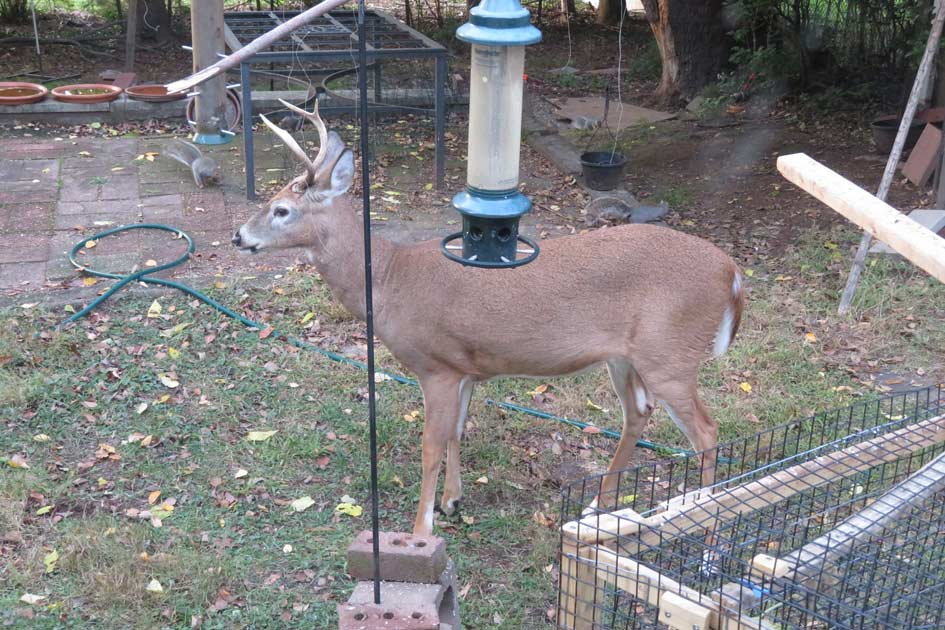
![]()
Whenever there's a need, birdfeeders are modified. These cedar feeders had several design shortcomings. Wood was inserted inside to guide seeds to the bottom and not get lodged on the inside supports. Also, to deter large birds, the places where birds can land were brought in much closer to the feeder. To allow peanuts in the shell and other larger seeds to slide to the bottom as birds ate from the bottom, wood "lifters" were placed to lift the bottoms of the plexi sides.
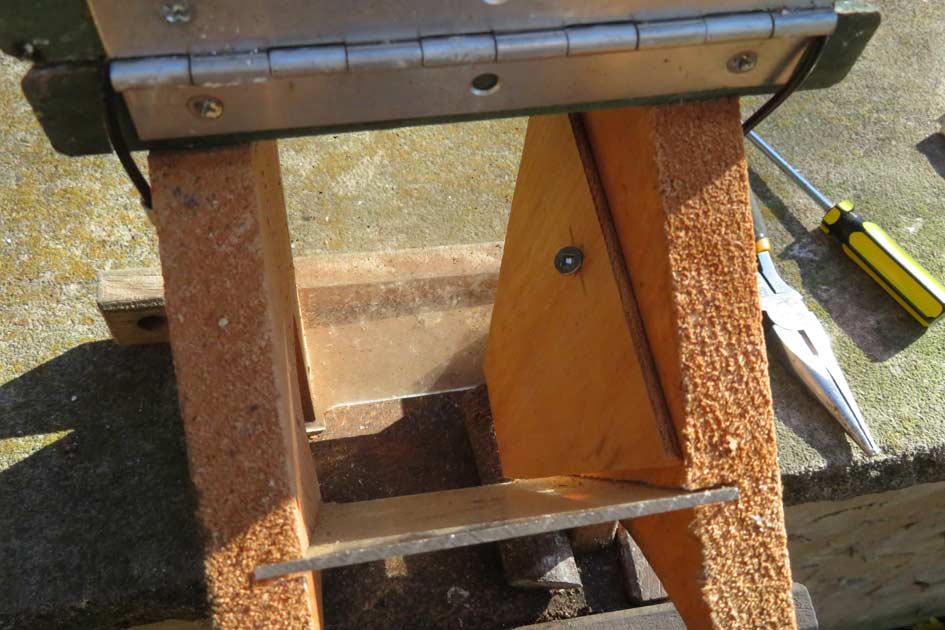
![]()
Modified cedar feeder. It also has a vertical piece of wood added, to make it easier for woodpeckers to eat.
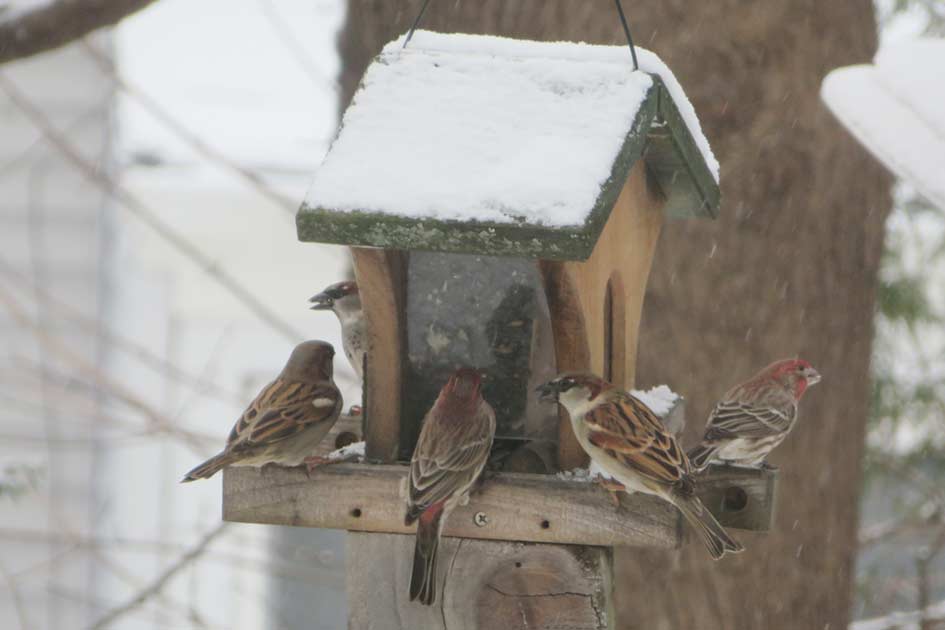
![]()
Squirrel Buster, ring model, custom weight adjustment, large capacity, expensive. Here it is suspended from a pulley much higher up in the tree. (More about filling and the pulley below.)
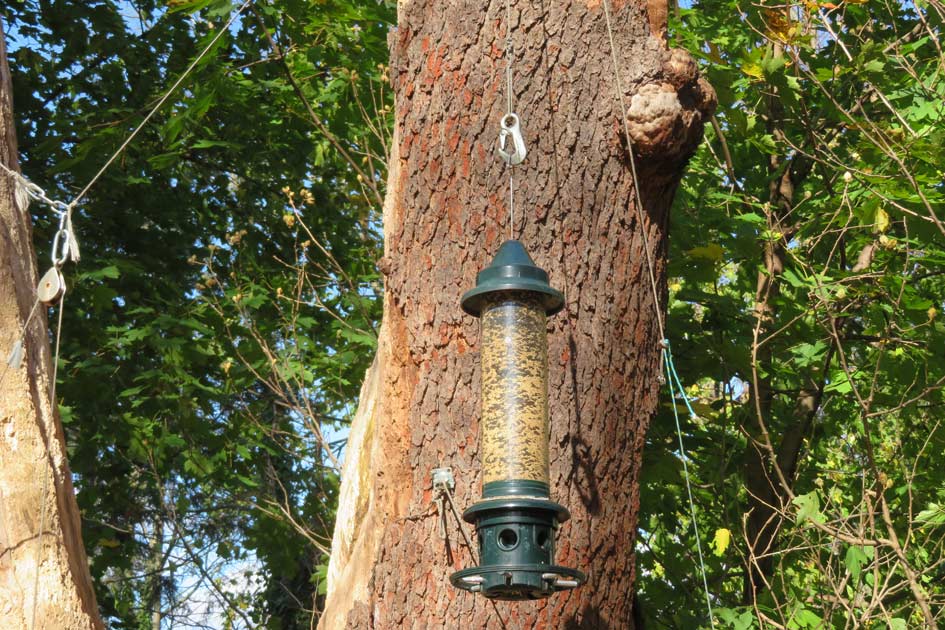
Squirrel busters on poles. These short poles — six feet tall (2 m) or less — are found in the big hardware store chains. Unfortunately we have lots of deer, so this arrangement didn't last very long.
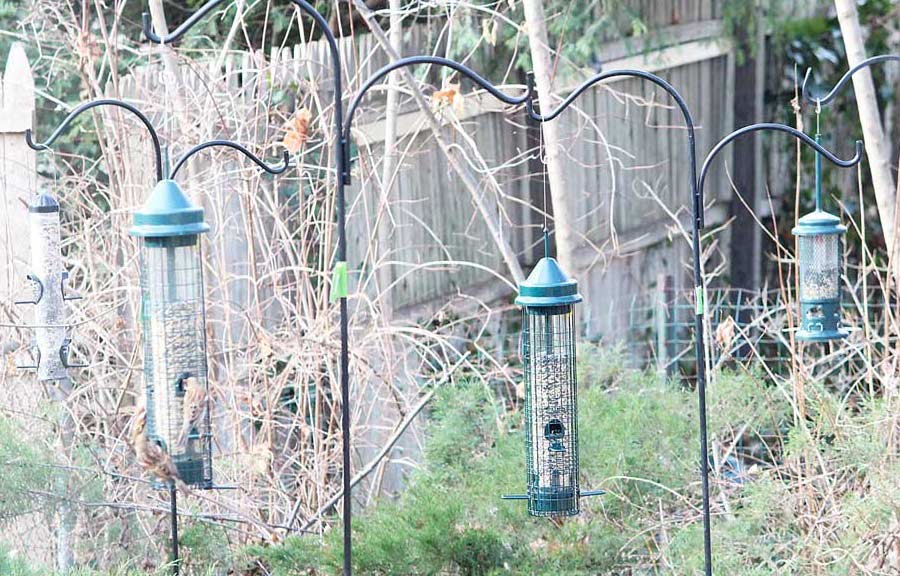
![]()
Platform feeder — easy for mourning doves to eat from, but also easy for starlings and other larger birds.
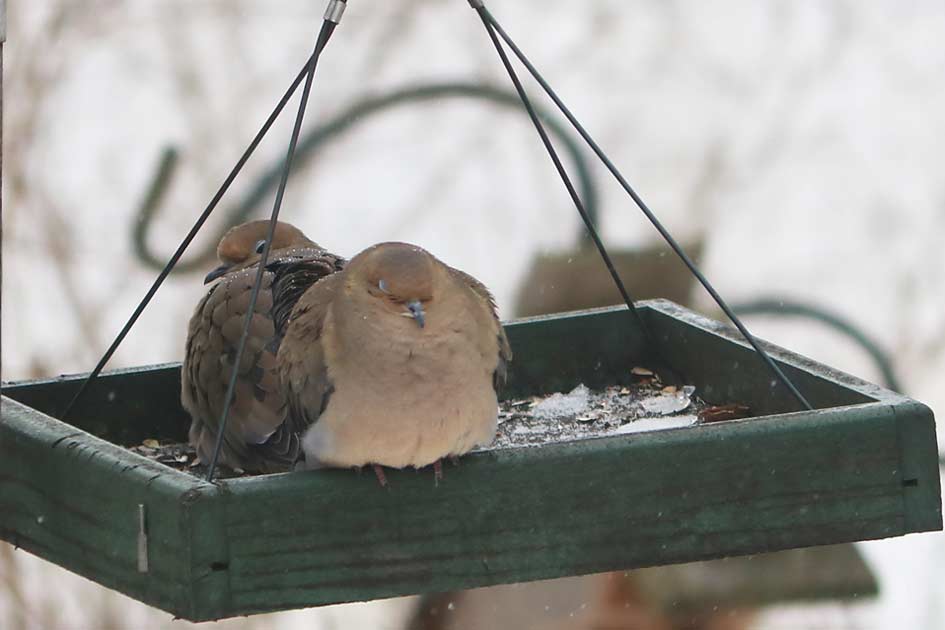
![]()
Water dish. Come in several sizes. Made in Italy, found in hardware stores, ideal for water for birds. Many will bathe or drink, including birds that don't come for the food, such as mockingbirds and robins. They have to be cleaned out pretty much daily (I use a scrub brush), since wild birds drink, bathe and poop in them. Grackles bring food from the feeders and dunk it in the water and then eat it.
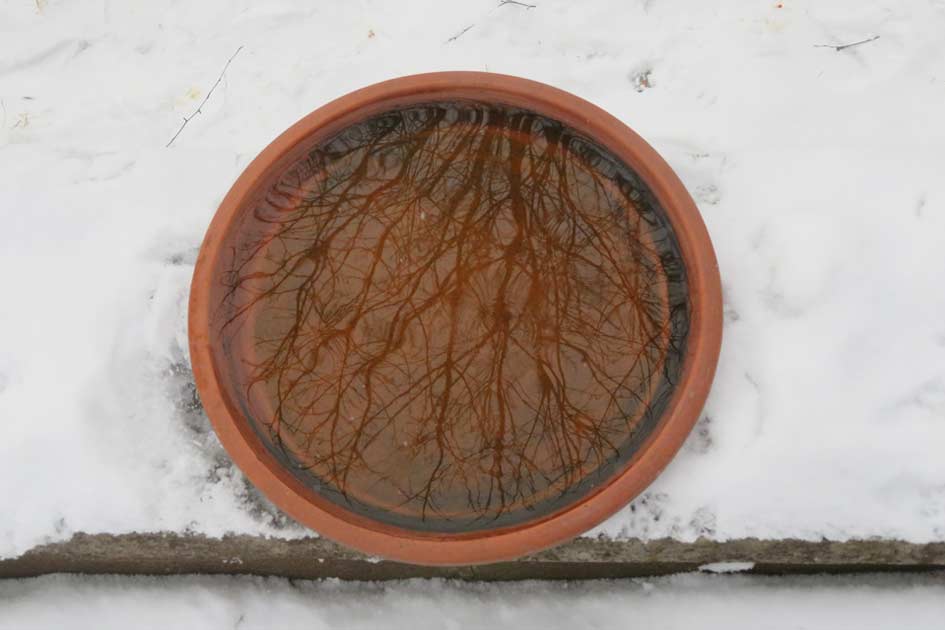
![]()
I've modifed the suet feeder by attaching some vertical wood, to make it easier for woodpeckers to eat.
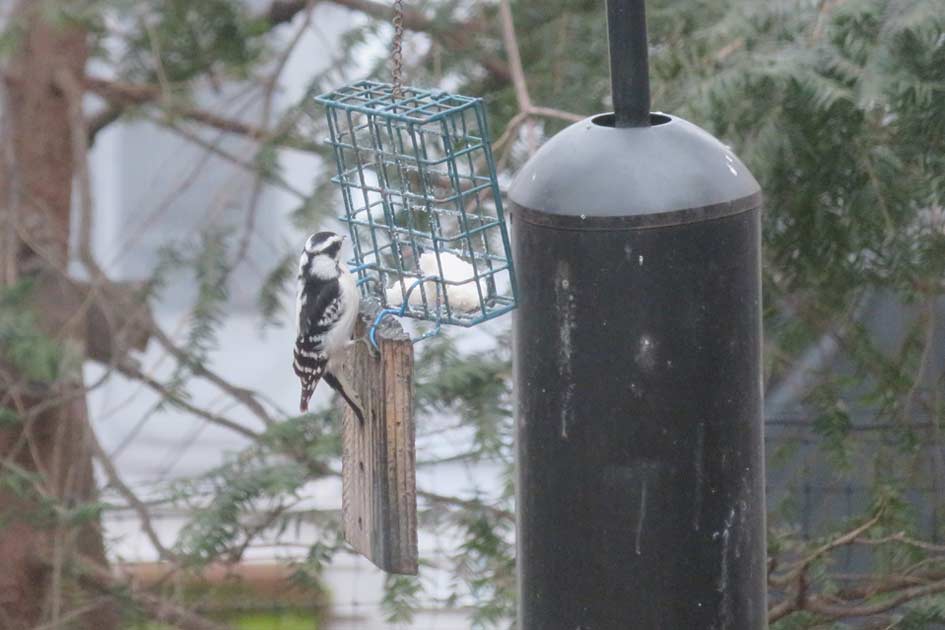
![]()
On the left, regular suet, found in many stores. On the right, "Simply Suet" which contains nothing except suet. Available from Wild Birds Unlimited. Starlings and many birds normally won't eat it, but woodpeckers enjoy it.
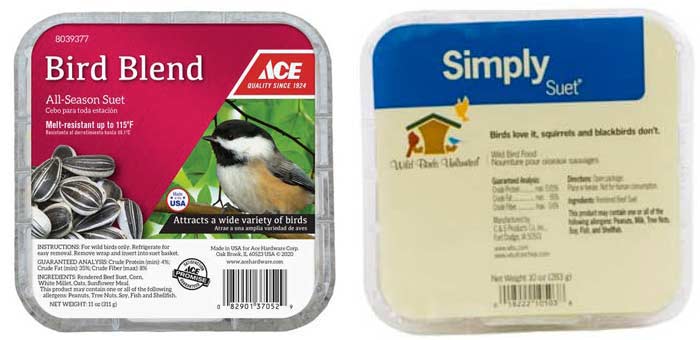
Early ugly attempts at rings, using clothes hangers. Straight lengths of wire hanging down, which didn't really do the job. Lengths of fishing line have to be hung from the ring. Later models use hula hoops as the rings.
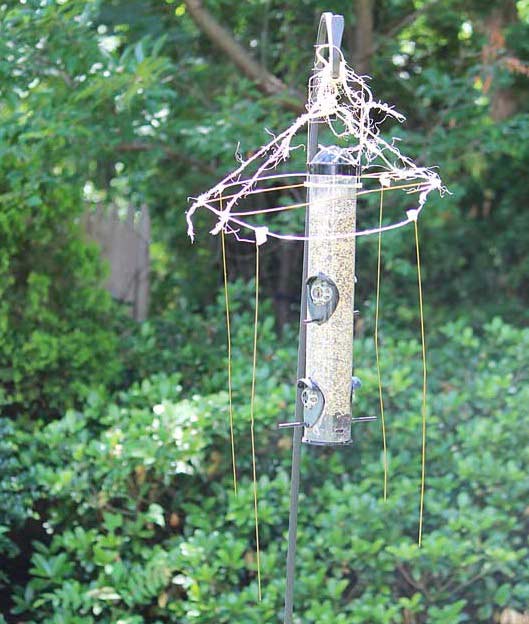
![]()
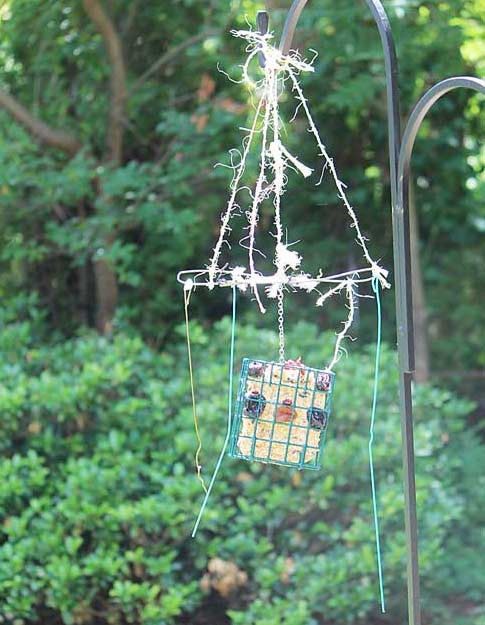
![]()
Hummingbird feeders are delightful, but I've seen a squirrel pry off the yellow "flowers". Also, because they're filled with sugary water, they have to be emptied out and cleaned regularly.
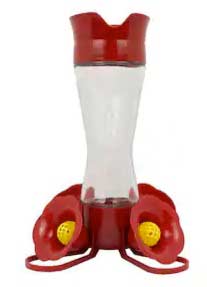

![]()
The "cage" style Squirrel Buster.
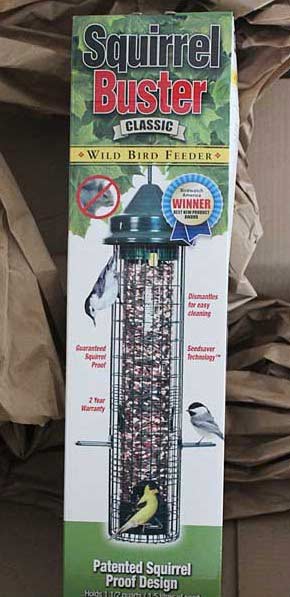
![]()
The smaller model Squirrel Buster. Finicky to take apart and fill and close, but squirrels cannot get at the seeds. They'll chew off the paint trying to gnaw through the metal cage.

![]()
Standard model Squirrel Buster.
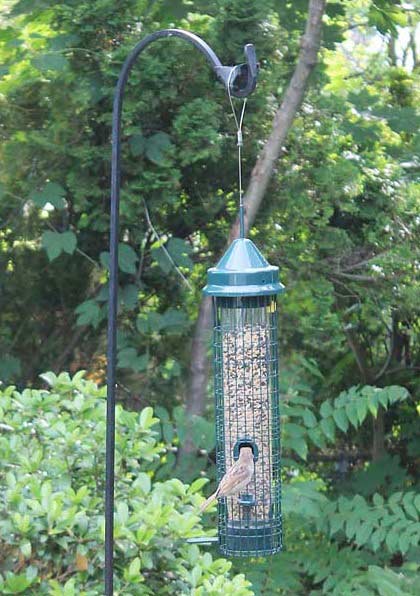
![]()
The outer "cage" is metal mesh, so birds like nuthatches can hold onto it the way they hold onto a tree trunk, upside-down.
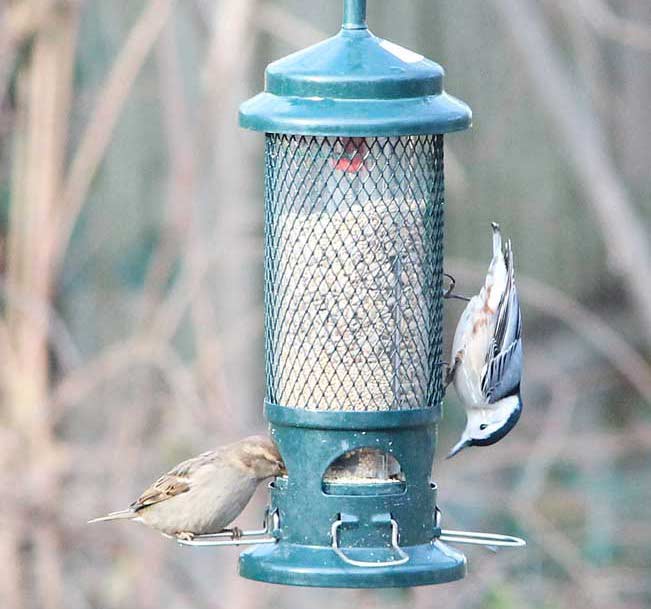
![]()
Plastic tube feeder that holds tiny nyjer seeds, with small perches and tiny holes. For house finches, goldfinches and chickadees. I've never seen a house sparrow able to get anything out of this feeder style.
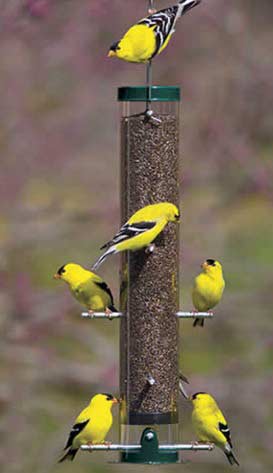
![]()
Closeup.
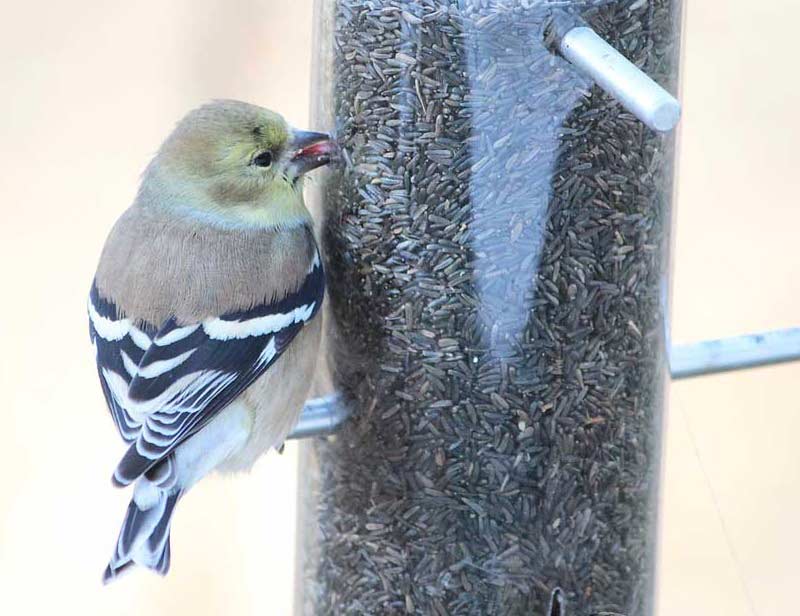
![]()
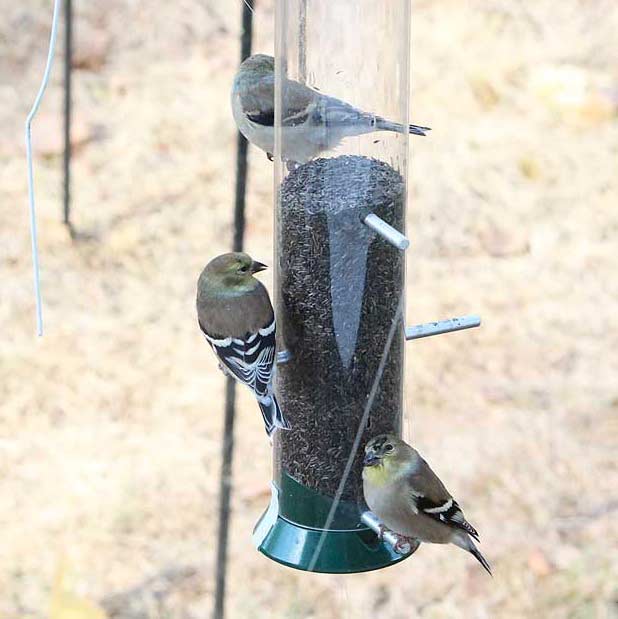
![]()
The tube feeder I use is similar to this design, only taller and green. I've tried drillling drain holes in the bottom, but if it rains, the seeds inside get damp and rot.
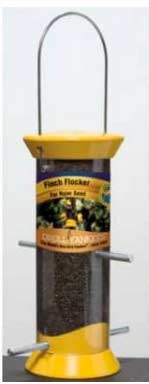
![]()
![]()
What birdseed is used
40 lb (18 kg) bags of mixed birdseed from Costco, which lists what seeds are in the bag — all seeds that wild birds like. There are no "junk" seeds, unlike the discount bags found in grocery stores, which contain things birds don't eat. Many cheap mixes don't list the ingredients by name.
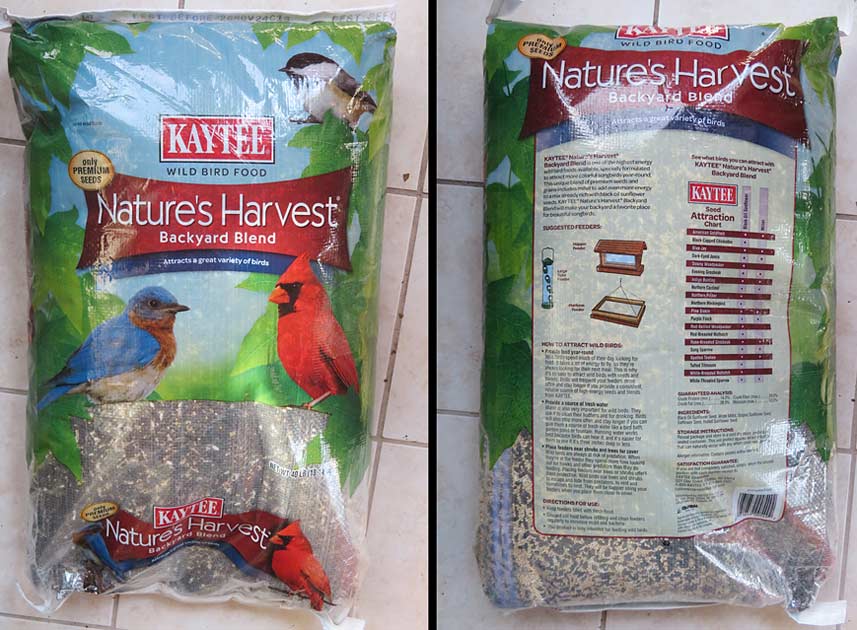
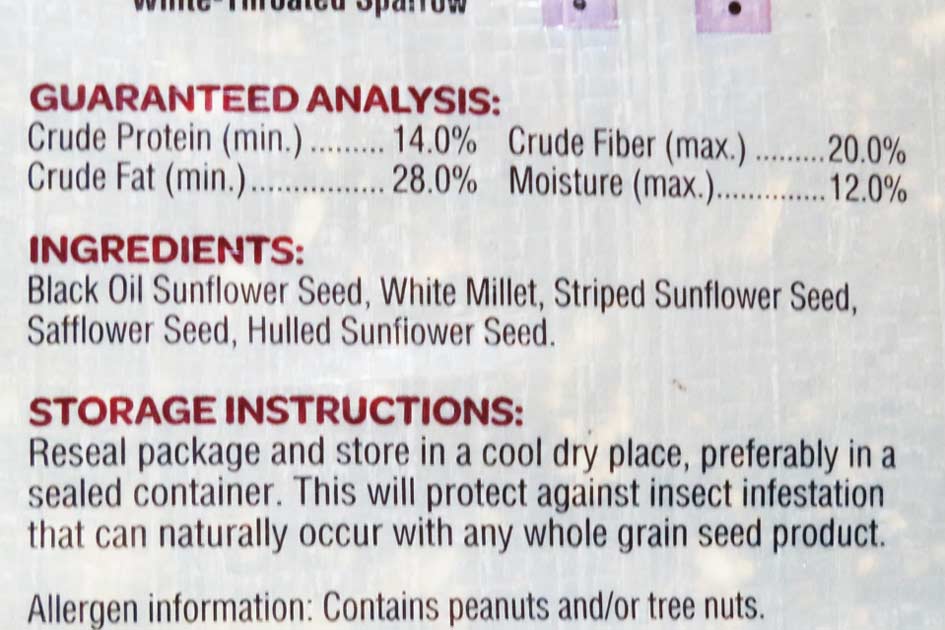
Bags of black oil sunflower seeds, found at the cheapest price in grocery store chains like ShopRite.
Bags of unsalted peanuts in the shell. Used to find them at $2 a pound ($4.40 / kg) and higher in local stores. Recently Costco has started carrying them and they run closer to $1 a pound ($2.20 / kg).
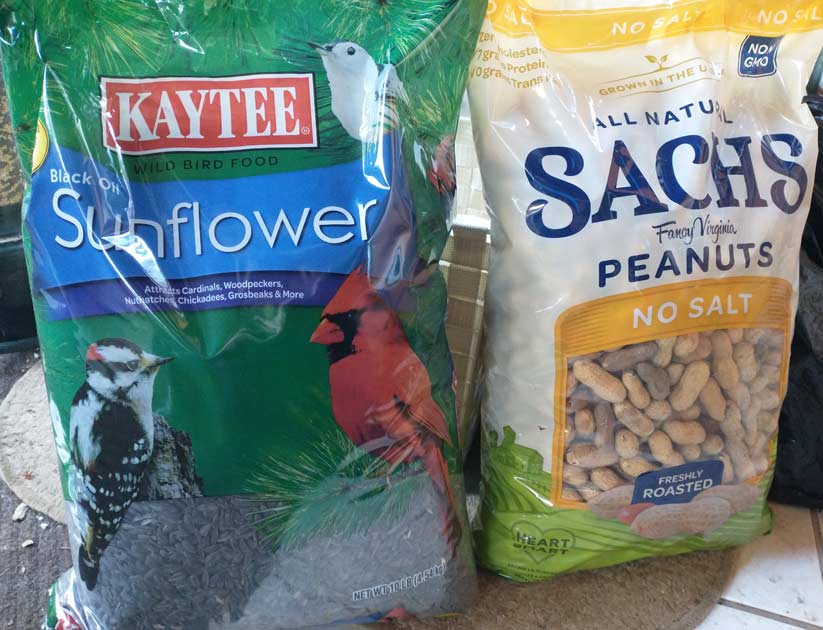
![]()
Before the starlings came (there were several years of starling-free feeders) I put out shelled peanuts and shelled sunflower seeds. Now that the starlings are in the neighbourhood, such goodies can only be put out if I sit outside and guard the feeders. A high-powered stream of water makes them fly out of the yard, often landing close by and waiting until I go back inside the house. Fortunately, starlings can't eat seeds still in the shell and peanuts still in the shell, so that's what I put out now.
I keep the mix in a vermin-proof container.
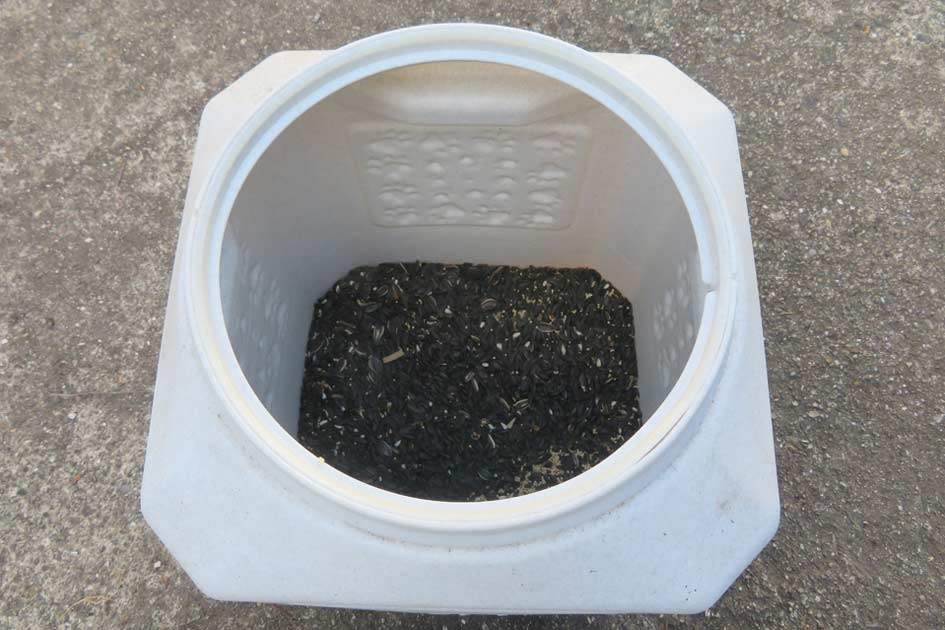
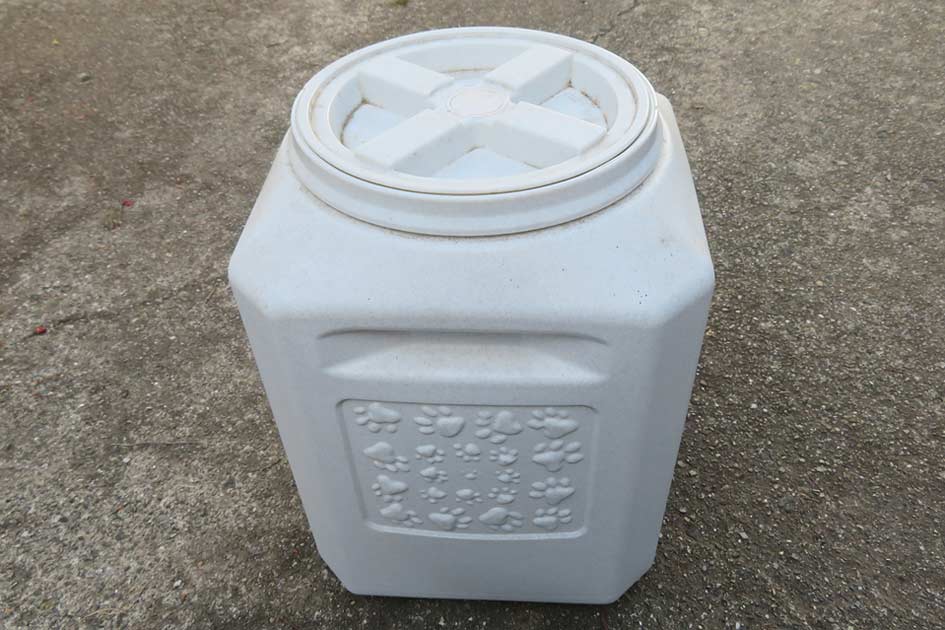
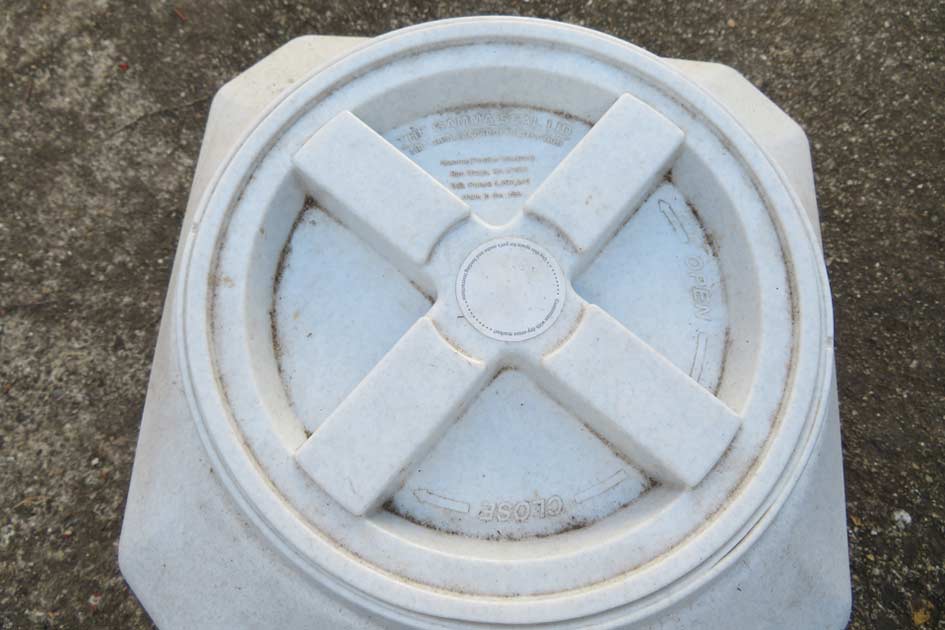
How I scoop out the seed mix.
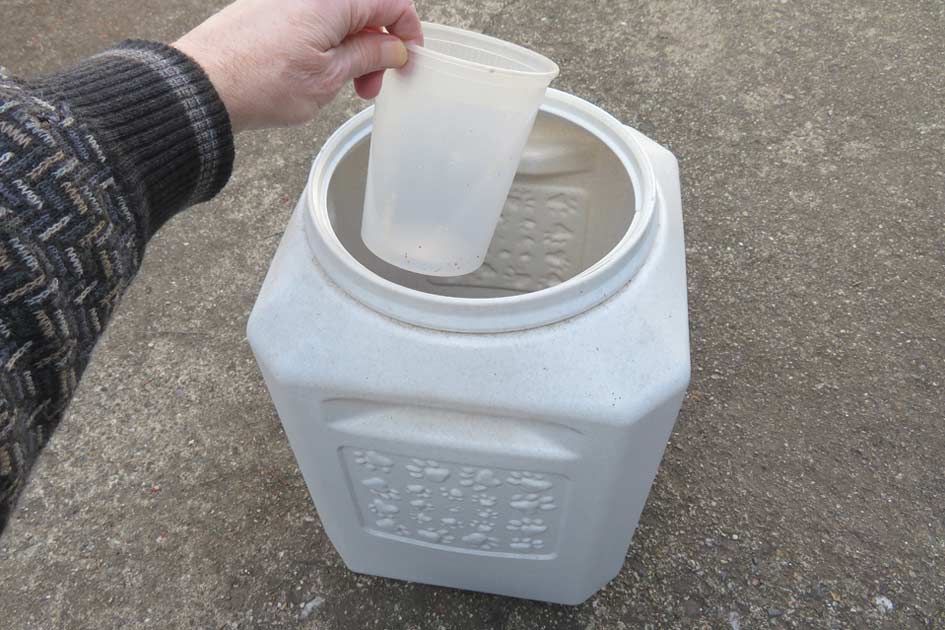
How to get most of the mix into the feeder: a home-made funnel from cereal boxes and duct tape. The perfect diameter for the bottom of the funnel is the centre of a roll of toilet paper.
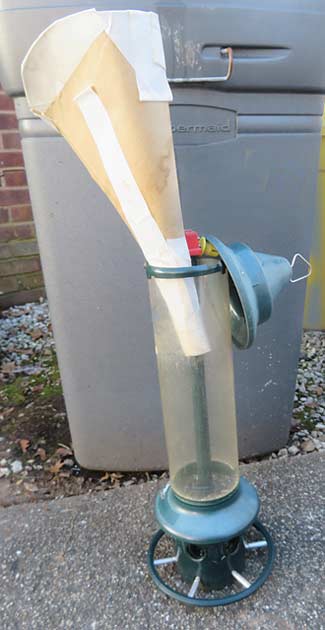

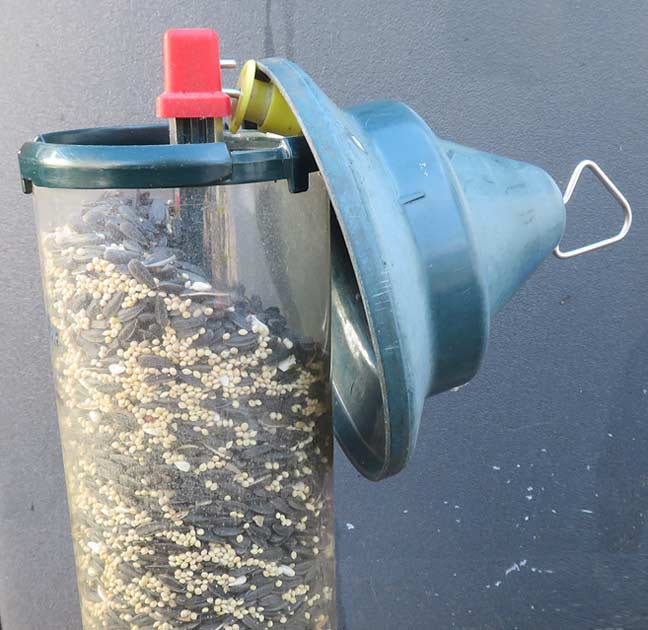
The mixed-seed birdfeeder hangs on a pulley.
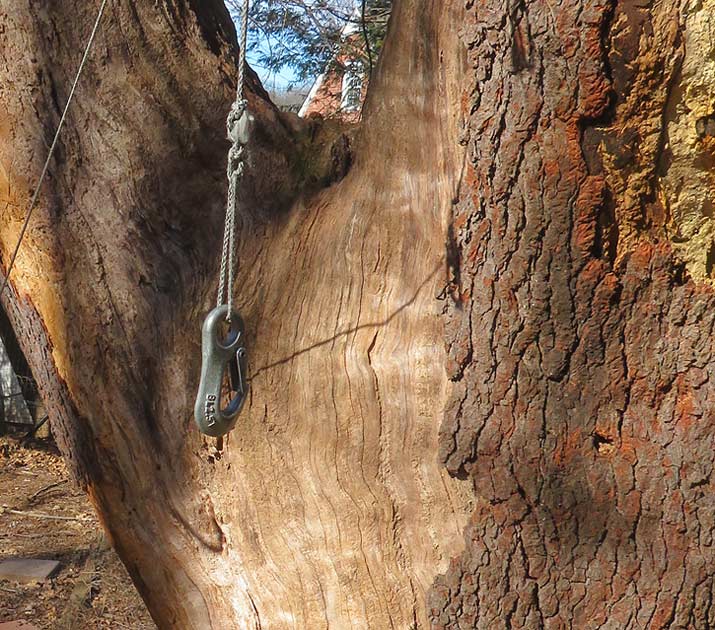
With some hardware bought at a hardware store, the birdfeeder is clipped to the bottom of the rope.
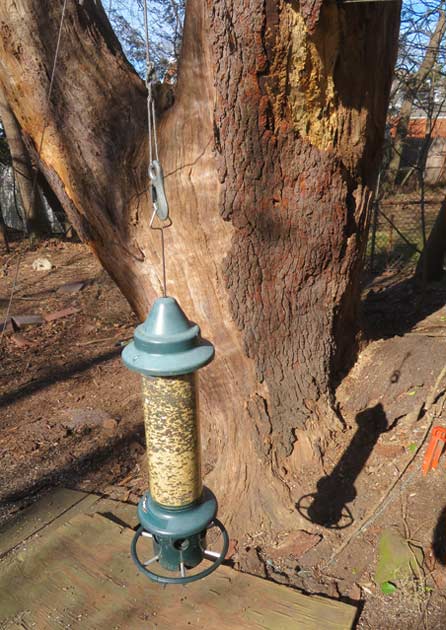
Pulling on the pulley to lift the birdfeeder over the heads of deer.
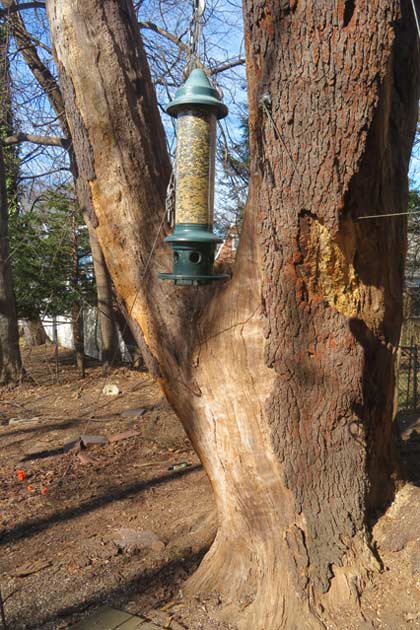
Pulley mechanism high above the feeder.
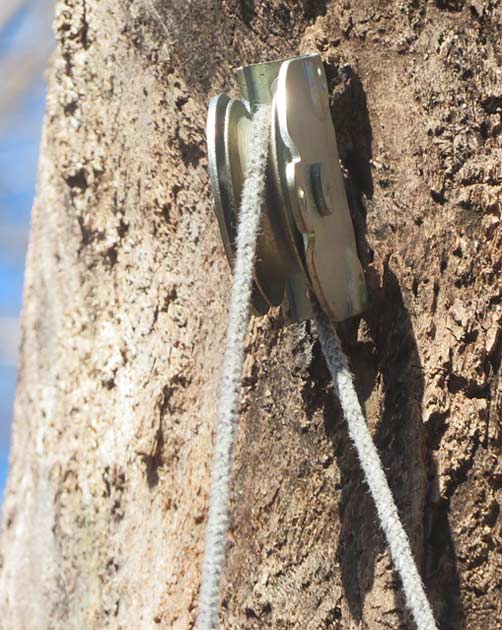
Once the feeder is pulled up into the air, the rope is kept taut with big tent hooks in the ground.
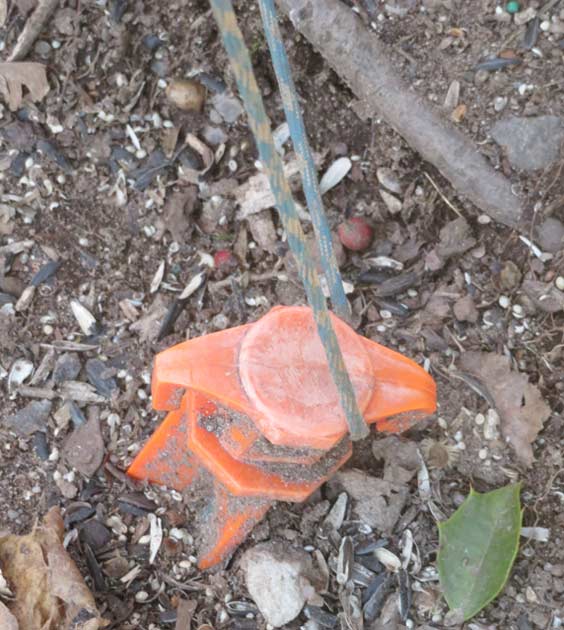
Once in a while I put the mix on the ground. Some of the birds that hesitate to use a birdfeeder, especially the winter visitors (white-throated sparrows and juncos) dash into view and grab a bite.
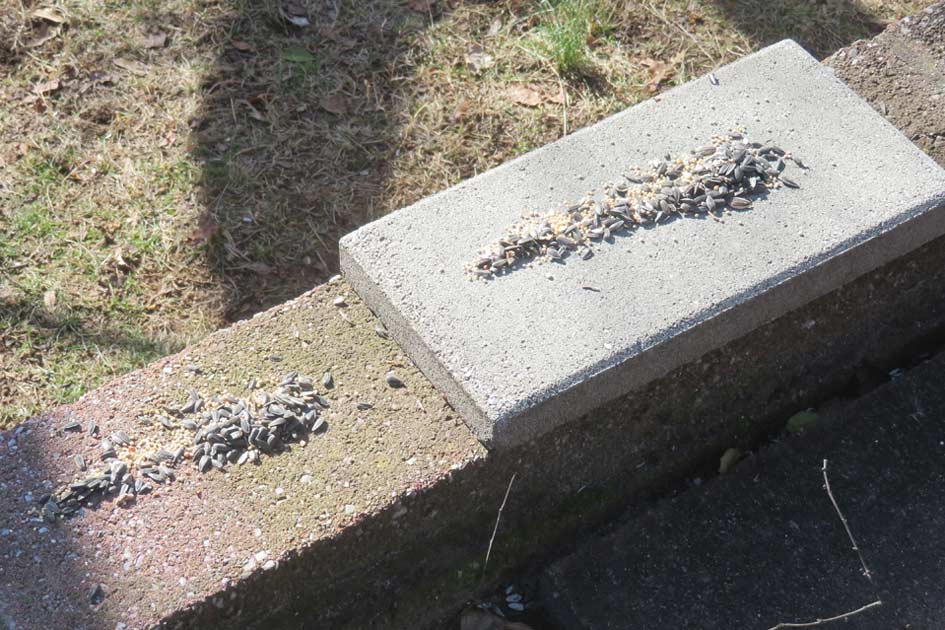
Naturally, squirrels will arrive, and they can shell and eat a black-oil sunflower seed in about two seconds.
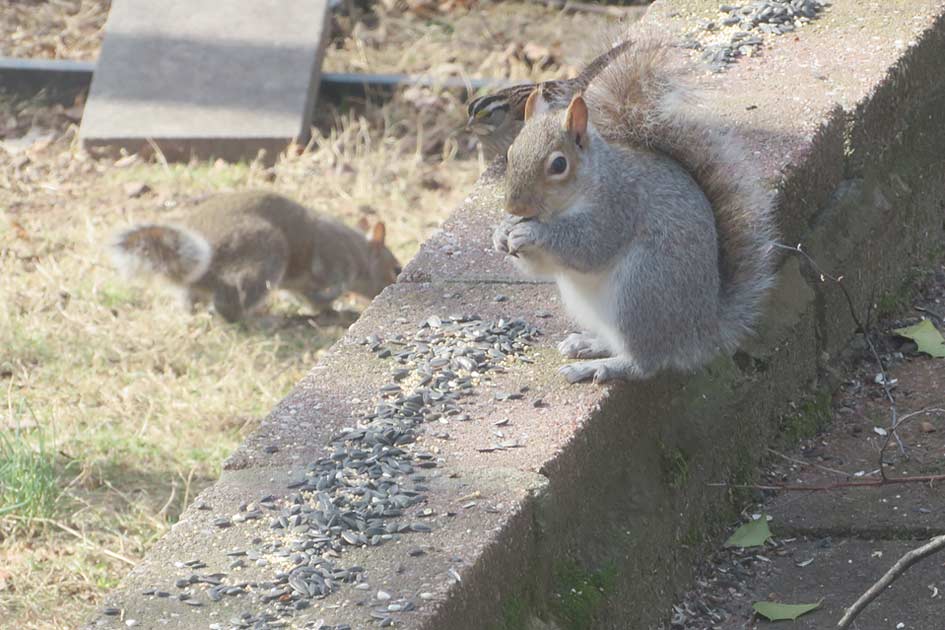
Not mentioned above: I used to put out inexpensive "dog kibble" which had as its main ingredient corn. The birds gobbled it up. Grackles would bring the bits to a water dish to soak and eat. But, sadly, as with any food that doesn't have a tough shell, starlings would empty the feeders rapidly. So, no more dog kibble.
![]()
Updated 2024.02.07